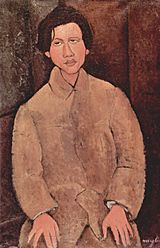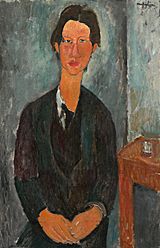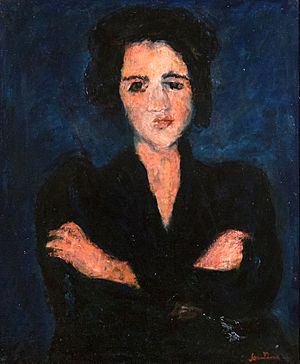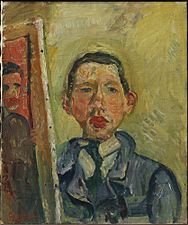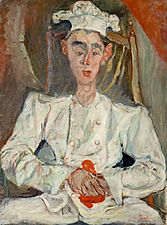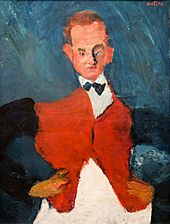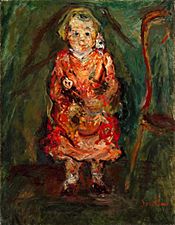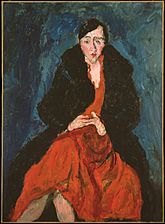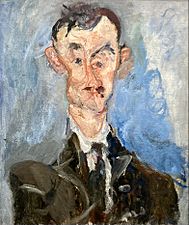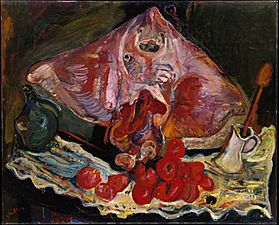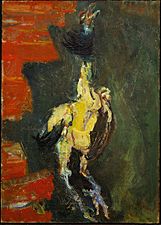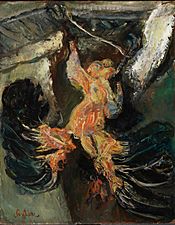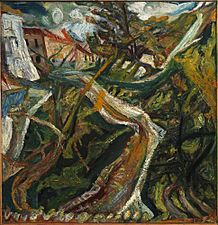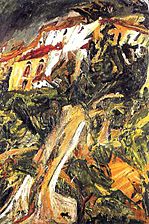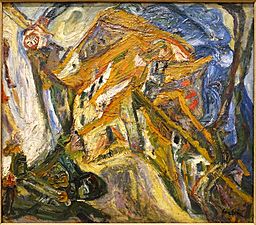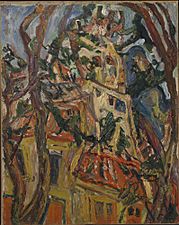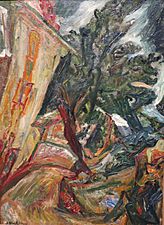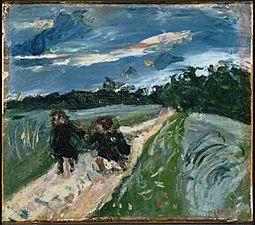Chaïm Soutine facts for kids
Quick facts for kids
Chaïm Soutine
|
|
|---|---|
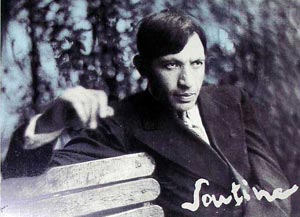
Chaim Soutine (with signature)
|
|
| Born |
Chaim-Iche Solomonovich Sutin (Хаим-Иче Соломонович Сутин)
13 January 1893 |
| Died | 9 August 1943 (aged 50) Paris, France
|
| Education | Vilna Academy of Fine Arts, École des Beaux-Arts, Fernand Cormon |
| Known for | Painting |
| Movement | Expressionism |
| Patron(s) | Albert C. Barnes, Leopold Zborowski |
Chaïm Soutine (born January 13, 1893 – died August 9, 1943) was a famous French painter. He was born in Belarus and was Jewish. Soutine played a big part in the expressionist art movement while he lived and worked in Paris.
He loved classic European paintings, like those by Rembrandt and Courbet. Soutine created his own unique style. He focused more on shapes, colors, and textures than on making things look exactly real. His art helped connect older painting styles with newer ones like Abstract Expressionism.
Contents
Early Life: A Young Artist's Start
Soutine was born as Chaim-Iche Solomonovich Sutin. This was in a place called Smilavičy in what was then the Russian Empire. Today, this area is part of Belarus. He was Jewish and had ten brothers and sisters.
From 1910 to 1913, Soutine studied art in Vilnius. In 1913, he moved to Paris with his friends Pinchus Kremegne and Michel Kikoine. There, he studied at the École des Beaux-Arts. Soon, he began to develop his very own special way of seeing and painting the world.
Career: Painting in Paris
For a while, Soutine and his friends lived at La Ruche. This was a place in Montparnasse where artists who didn't have much money could live. There, he became good friends with Amedeo Modigliani. Modigliani painted Soutine's picture several times. One famous portrait was painted in 1917 on a door!
An art dealer named Léopold Zborowski helped Soutine a lot. He supported Soutine during World War I. He even took the artist to Nice to keep him safe from the war in Paris.
After the war, another important art dealer, Paul Guillaume, started to promote Soutine's art. In 1923, a rich American collector named Albert C. Barnes saw Soutine's paintings. He bought 60 of them all at once! Soutine, who had been very poor, immediately took the money. He ran into the street, hailed a taxi, and told the driver to take him all the way to Nice. That's more than 400 miles away!
Carcass Paintings: Art and Hygiene
Soutine once shocked his neighbors by keeping an animal carcass in his studio. He wanted to paint it, like in his famous Carcass of Beef series. The smell was so bad that his neighbors called the police! Soutine then explained to the police that art was more important than cleanliness.
There's a story that Marc Chagall, another artist, saw blood from the carcass leaking into the hallway. He supposedly ran out screaming, "Someone has killed Soutine!" Soutine painted 10 works in this series. These paintings are now some of his most famous. He got the idea from Rembrandt's painting Slaughtered Ox, which he saw at the Louvre museum.
Soutine painted most of his works between 1920 and 1929. From 1930 to 1935, a designer named Madeleine Castaing and her husband became his patrons. They let him stay at their summer home. This allowed Soutine to have his first art show in Chicago in 1935. He didn't often show his work. But in 1937, he took part in a big exhibition in Paris. There, he was finally recognized as a great painter.
German Invasion: Hiding from Danger
Soon after this, German troops invaded France. Soutine was Jewish, so he had to escape from Paris. He had to hide to avoid being arrested by the Gestapo. He moved from place to place. Sometimes, he even had to sleep outdoors in forests to stay safe.
Illness and Death: A Sad End
Soutine was very sick with a stomach ulcer. He was bleeding badly. He left his safe hiding place and went to Paris for emergency surgery. Sadly, the surgery did not save his life. On August 9, 1943, he died from the ulcer. He was buried in Cimetière du Montparnasse in Paris.
Legacy: Soutine's Lasting Impact
In February 2006, one of his famous "beef" paintings, Le Bœuf Écorché (1924), sold for a record £7.8 million (about $13.8 million). This happened at an auction in London. In February 2007, a portrait from 1921 called L'Homme au Foulard Rouge sold for $17.2 million. This set a new record for his art.
Another beef painting, Le bœuf (around 1923), sold for $1 million in 2004. Six months later, it sold for twice that price to the National Gallery of Art in Washington, D.C. Later, in May 2015, Le Bœuf reached an even higher price. It sold for $28,165,000 at an auction.
The famous writer Roald Dahl even included Soutine as a character in his 1952 short story "Skin".
The Jewish Museum in New York has shown Soutine's work in major exhibitions. These include "An Expressionist in Paris" (1998) and "Chaim Soutine: Flesh" (2018).
In 2020, Soutine's painting Eva became a symbol for people protesting for democracy in Belarus.
Gallery
Portraits and Figures
Still Lifes
Landscapes
-
Chemin de la Fontaine des Tins at Céret, c. 1920
See also
 In Spanish: Chaim Soutine para niños
In Spanish: Chaim Soutine para niños
- School Of Paris
- Marc Chagall
- Isaac Frenkel Frenel
- Jules Pascin
- Michel Kikoine
- Paris


